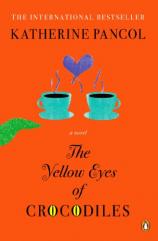Author Talk: November 2013
Question: The title of your book refers to Antoine’s new life and livelihood in Africa, but it also seems to work as a metaphor of sorts. What does it mean to you?
Katherine Pancol: One morning when I was in New York I read an article in The New York Times about a man who went off to raise crocodiles because he was sure he would make a fortune. He was like a Forty-Niner during the Gold Rush. As it happens, raising crocodiles can be very profitable, because every part of the animal can be used, from its hide to its blood and claws. Antoine thinks he’ll make a fortune and realize his dream of becoming a rich, powerful businessman. In fact, the opposite happens. He winds up bankrupt and despairing, tracked by the crocodiles who watch him at night, waiting to get close enough to devour him. The crocodiles’ yellow eyes shining in the darkness represent the appeal of riches, the glittering gold that leads men to their doom—and women, too.
I think the story illustrates the situation modern people are in. They’re dealing with their bosses, bankers, creditors, and sometimes their partners, while being tracked by “crocodiles” who have just one thing in mind: swallowing them whole.
Q: Joséphine is a medieval history scholar. Why did you choose this particular time period as her area of interest, and what inspired the story of Florine specifically as the subject of Jo’s novel?
KP: I always begin my novels with a bare-bones story and a few little details, which then grow like a snowball. Here is how CROCODILES got started: I own a small seaside house in Normandy, and I love to go swimming early in the morning when there’s nobody else around. The beach isn’t “a” beach anymore, but “my” beach. One day I met a woman on “my” beach, and was very upset. Who did she think she was, daring to come on my beach? But we swam and talked, and then started to have coffee together after swimming, and we became friends. It turns out she worked as a high-level university researcher. These eminent professors can spend their lives studying very, very specific times and topics in French and world history.
This woman was an expert on the periodicals that itinerant peddlers sold to girls in the eighteenth-century French countryside. I was fascinated, and I asked her hundreds of questions, sensing that I might have the beginning of a story. I also learned that this woman had two daughters; one of whom was very nice, and the other of whom was hateful and mean to her.
So for CROCODILES, I stole her job, her daughters, and the kind of sweetness and passivity she had about her. But I decided that Joséphine’s period would be the twelfth century, because it isn’t studied much in French schools (we usually start around the fourteenth century), and I figured I would learn a lot of history I didn’t know. I love learning new stuff. I feel unhappy if I don’t learn something new every day.
Q: Like your character Iris, you studied film writing at Columbia University. How has this experience informed your writing style?
KP: Being at Columbia in the 1980s was the icing on the cake, because by then I had already been working on writing. I read a lot as a girl, all sorts of books. I would go to the library and read authors in alphabetical order. I must’ve read Dostoevsky when I was twelve! We didn’t have a television, so in the evening I would read, and I majored in comparative literature, studying all the great French, American, Russian, and German writers. I became a journalist, first for Paris-Match, and then for the French Cosmopolitan. There I met a terrific woman named Juliette Boisriveaud, who taught me how to write. She must have felt I had talent, and she got me to “deliver” my words.
I published my first novel, MOI D’ABORD, in 1979. It was a huge success in France, selling more than 300,000 copies. This allowed me to go live in New York, and thanks to a friend, I was able to audit creative writing classes at Columbia. What a joy that was! Talking about narrative structure, the rhythm of paragraphs, building the intensity of a plot. It was a pleasure spending two years around people who were as passionate about writing as I was. I had a wonderful time, and I came away with that classic piece of advice, “Show, don’t tell.” Don’t write, “It was snowing.” Instead, show the footsteps in the snow, the crunch of snow under your boots, how wet gloves feel or smell.
Q: All of the characters in this book seem to be experiencing what Americans call a “midlife crisis.” What makes midlife such a challenging period, and how, in your opinion, can we manage it more gracefully?
KP: There is a moment in CROCODILES when Joséphine says that you can’t always avoid making the big choices in life. You have to decide, not let somebody else do it for you.Who am I? What do I want to do? Where is my place in the world? Why am I afraid? Am I responsible for what happens to me? Etc. At some point, you have to answer those questions. Face life without cheating. If you don’t, if you lie to yourself, you can find yourself facing failure, illness, divorce, or unemployment. In other words, life has made the decision for you. It’s saying, “You don’t want to choose how to live? I’ll force you to.” And that’s what makes a novel: the confrontation between life and you, the moment you are facing yourself and you have to take your life in hand, or it will escape you. It’s a very dramatic moment. But life is generous; it gives you time, doesn’t hit you all at once. It usually gives you several chances to change and grow. But if you run away each time, it will come crashing down on you. And that’s often what’s called a midlife crisis.
Q: Among the themes you explore is the notion that it’s never too late to reinvent yourself, or even to get to know yourself. Can you talk about this idea and how it came to be part of the novel?
KP: I think life is like a dance partner—sometimes it sweeps us off in a glittering waltz, and our head spins with happiness. Sometimes it steps on our toes and causes us pain. You have to accept every part of the dance. Not just hold on to the moments of happiness but also take advantage of the times when nothing is working to ask yourself what you can learn from them. And while you’re learning, you reinvent your life, you begin it anew. There’s no particular age to start again. The main thing is to stay alive, really alive. To learn, to challenge yourself, to move ahead. Not to sit on the sidewalk feeling sorry for yourself, but get up and move on. To waltz with life!
Q: THE YELLOW EYES OF CROCODILES features multiple interwoven narratives. What was your process for creating and juggling the storylines?
KP: E. M. Forster says that a novel’s action has to come from inside the characters and their psychology, and not be imposed from the outside. That’s why you have to spend time working on your characters. You must know everything about them, including details that you won’t use but are part of the person’s dynamic and add to the richness of the plot. Before I start writing, I spend a lot of time with my characters, like a theater director rehearsing every scene. The characters become so intense and alive that when they step onstage I hear a voice in my head yelling, “Action!” And then I watch and follow them. All I have to do is write.
Q: As you alternate points of view, even the most flawed characters here are given a chance to tell their story, and the reader is able to identify with their insecurities and disappointments. Which characters surprised you along the way?
KP: They all surprised me! Even if I know many things about them, when they step onstage, they can always slip away and go off in some direction I hadn’t expected. It’s like raising children. You think you’ve given them the best of everything, and nourished them with beautiful things and beautiful values. And then they can go off the rails completely, or else they do things that are so wonderful you couldn’t have imagined them! When I start a novel, my characters are all very well behaved, and they do what I tell them. By the time I reach the end, I’m struggling to chase after them to wrap up the plot, and they’re running off in every direction.
Q: Iris is concerned that the book Joséphine has written is “women’s fiction.” How do you feel about this genre and how would you categorize your own writing?
KP: I find that kind of question very hard to answer. I write, I’m happy when I find just the right word; I tell stories, and I tell myself stories. I don’t know who will read them and, to be honest, that’s not my concern. I know that women tend to buy novels, but that’s all. Having said that, I get lots of e-mails from men who write me after reading books they borrowed from their wives!
Q: There are two sequels to THE YELLOW EYES OF CROCODILES. What is it about these characters that keeps you coming back to them?
KP: It’s their fault! They just won’t go away! Usually when I finish a novel the characters disappear once I write “The End.” But when I finished CROCODILES, I realized they weren’t leaving. They were staying in my life. I thought about them all the time. I would wonder what they were doing, who they were becoming. So I wrote LA VALSE LENTE DES TORTUES (THE SLOW WALTZ OF THE TURTLES) in 2008. And when that was finished, they came tiptoeing back again, and I got the idea for the first scene of LES ÉCUREUILS DE CENTRAL PARK SONT TRISTES LE LUNDI (THE CENTRAL PARK SQUIRRELS ARE SAD ON MONDAY) in 2010. So we’re off again!



